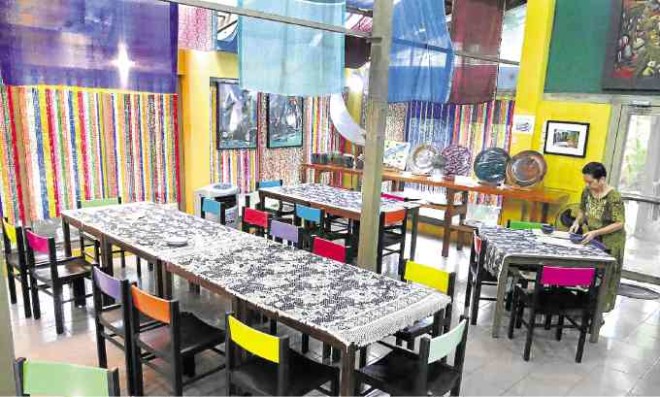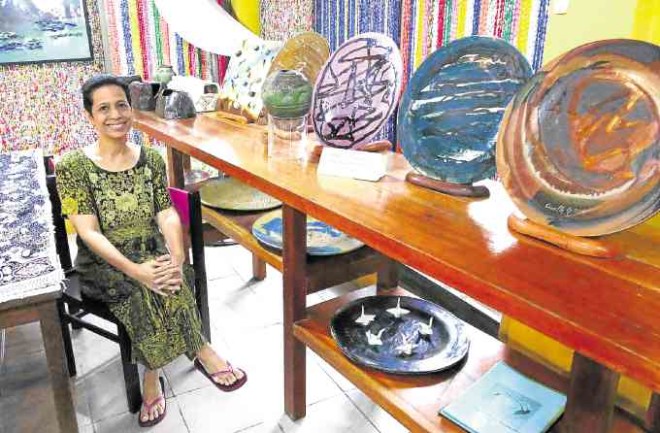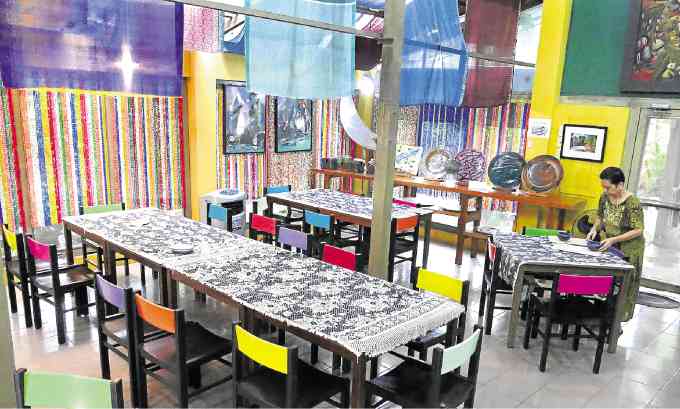
Many years ago, when she was just beginning to learn the art of pottery in Japan, Lanelle Abueva would make a hundred tea cups or a hundred rice bowls a day.
At the end of the day, her sensei would examine her work carefully, select a dozen or so pieces to be sold, and destroy the rest.
This went on for months.
Finally, she asked her teacher: what was he looking for? What was it in those pieces that he selected that made them different from the ones that he threw away?
He replied, in Japanese, that he was looking for “life.”
It took some time for Abueva to understand what he meant. Her Japanese was rudimentary, and she sensed that the concept her teacher was trying to communicate wasn’t easily put into words.
“After a while, I got it, but I still couldn’t explain it,” recalls Abueva.
One could delve into the Japanese aesthetic of wabi-sabi, which finds beauty in simplicity and imperfection, in roughness and modesty.
Or one could simply pick up one of Abueva’s stoneware pieces, feel its weight and its shape in one’s hands, appreciate the shifting textures and colors of the glaze, see the marks left by the creator’s hands in the clay, and understand without the need for words.
For the last 35 years, Abueva has been breathing life into clay at the Crescent Moon Café and Studio Pottery in Antipolo, long a favorite destination for Metro Manilans because of the distinctive menu developed by Abueva’s late husband, the lawyer and legendary epicure Teodoro “Bey” Fernando.
The café and the ceramics studio complement each other perfectly, because all the tableware in the café comes out of Abueva’s kiln, and it is in using them—as dinner plates and drinking cups and eating utensils—that the diners can fully appreciate the art and craft that went into making them. Many a visitor has left the dining table at Crescent Moon not only with a satisfied belly, but with a newfound appreciation for handmade ceramics.
Glass Bar
Last August, Abueva added the Glass Bar, an arts and crafts space that offers workshops on anything from pottery and photography to bicycle mechanics and yoga. It is run by her daughter Majalya, and is emerging as another focal point for the creative community that seems to be drawn to hills of Antipolo.
Once in a blue moon, Abueva will still throw a lump of clay on her foot-powered potter’s wheel and create a piece by hand. These are one-of-a-kind decorative pieces meant for exhibition and for collectors.
But most of her time is now taken up trying to meet the growing demand for handmade stoneware from hotels and restaurants that want distinctive tableware as a final flourish for their discriminating clientele.
Crescent Moon Café and Studio Pottery is a small-scale enterprise employing several highly-skilled artisans and craftsmen, trained by Abueva herself in the intricate processes involved in making handmade stoneware.
The raw material is critical. Abueva used to source her clay from small mines in Iligan and Bacolod and the Ilocos, but most of these have closed down. These days, cheaper and better clay can be had from Thailand.
The studio pieces are formed in plaster molds, then hand-
finished and fully dried before they can be glazed and fired. During the rainy season, the drying process could take weeks.
Two gas-fired kilns run nearly round the clock, since it takes several hours to fire the pieces, and several hours more for them to cool down.

Time- and labor-intensive
Making handmade ceramics is both a time- and labor-intensive process, and nothing can be rushed, but the results are well worth it. As the philosopher Herbert Read once wrote in “The Meaning of Art”: “Pottery is at once the simplest and the most difficult of the arts… Judge the art of a country, judge the fineness of its sensibility, by its pottery; it is a sure touchstone.”
In short, it is an advanced culture where people care about the cup their coffee comes in.
Abueva’s affinity for clay goes back to her early childhood.
Since she was seven years old, she and her playmates would go to her Tito Billy’s studio in University of the Philippines campus grounds in Diliman to play with his sculptor’s modelling clay.
“Tito Billy” is, of course, National Artist for Sculpture Napoleon Abueva, younger brother of her father, educator and constitutionalist José Abueva.
“What I really enjoyed was making things with my hands,” she recalls.
In due course, she enrolled in UP College of Fine Arts as a visual communications major, despite not being very good at drawing.
Neither was she really interested in sculpture, despite her Tito Billy’s influence.
The year she graduated, her father was seconded to the United Nations University in Tokyo, and it was there that she found her medium.
“Ceramics are everywhere in Japan—in the museums, the carinderias, the department stores, the alleyways,” she says.
Not only were ceramics everywhere, but ceramic art was exalted in Japan, to a higher degree than nearly anywhere else in the world. Master potters were considered “living national treasures,” and historic tea bowls and vases were venerated museum pieces.
There was no better place to learn how to make ceramics than Japan, but in order to do so, Abueva had to accept the traditional way of learning, which was to apprentice to a master.
Luckily, a mutual friend introduced her to Shokichi Aoki, one such master.
“He accepted me immediately when he found out that my grandparents had been killed by the Japanese in Bohol,” she says. “He had been a filmmaker for NHK and had been to the Philippines during the occupation, making propaganda films.”
Sensei Aoki’s atelier was in Hachijo-jima, a subtropical island more than an hour’s plane ride from Tokyo that used to be a penal colony. Appropriately enough, Hachijo-jima was in that part of the Pacific known as the Philippine Sea.
Apprenticing to a master required total commitment. No tuition was paid, but the apprentice was expected to work from 6 a.m. to 6 p.m. Much of the time was spent doing household chores, helping in the kitchen, cleaning the studio, and the rest learning by watching and doing.
Abueva had learned to speak a little Japanese, but there was very little talking anyway.
“We didn’t complain,” recalls Abueva. “We could see how sincere the teacher was in wanting to pass on everything he knew to his students.”
In her third year, however, Aoki-sensei died suddenly. His own teacher, Nakazato-sensei, a 14th-generation master of Korean descent who was one of Japan’s “living national treasures,” adopted his students. Keeping the tradition alive was of paramount importance.
By that time, however, Abueva was ready to try something new.
Unlearned
The free-wheeling yearlong ceramics course she took in Sun Valley, Idaho the following year was the complete opposite of the Japanese way of pottery.
“I unlearned a bit of what I had learned in Japan,” she recalls. “There was no teacher, per se. There would be different speakers and teachers who would influence you, open your mind, and you would start working. You could make anything you wanted, try anything. There were 10 kilns, and you were encouraged to make and formulate your own glazes.”
When she came back to the Philippines in 1981, Abueva combined everything she had learned in Japan and the United States and began to develop her own style.
The first 10 years were rough. “Nobody wanted my pieces,” she says. “They weren’t uniform, they looked unfinished, the glaze ran.”
People weren’t ready for the handmade look: they wanted pieces that were perfectly shaped, perfectly identical.
Then, after the Mt. Pinatubo eruption in 1991, Abueva started incorporating volcanic ash in her glaze. That became her signature, and garnered some attention.
By that time, people were also beginning to appreciate handmade ceramics. Orders started coming in, some from posh restaurants and hotels.
Abueva joined the small circle of Filipino ceramics artists that included Jon and Tessy Pettyjohn, Ugu Bigyan and Nelfa Querubin.
In 1997, she opened Crescent Moon Café and Studio Pottery with her husband Bey Fernando, whose culinary skills attracted as many visitors as the ceramics. The café remains one of Antipolo’s culinary destinations, a tribute to Fernando, who passed away in 1998.
Meanwhile, Abueva’s art has continued to evolve despite the business end of the pottery studio taking up most of her time.
“Your creativity doesn’t grow because of this business,” she says. “Customers come, they want certain things, I make the pieces and glaze it the way I want, and they approve it. I have to compromise.”
Creating pieces for exhibit, as in “If I Could Paint,” her recent show presented by Hiraya Gallery at the Makati Shangri-La Hotel, requires a different mind-set.
“I use the ceramic slabs as a canvas,” she says. “I carved them and painted on them and glazed them individually.”
There are encouraging signs that ceramic art is thriving in the Philippines, she says. Not only does the UP College of Fine Arts have a good ceramics program and a kiln, but younger ceramic artists are beginning to build their own kilns and are starting their own studios.
Signs of “life.”
Visit www.crescentmoonantipolo.com.









































